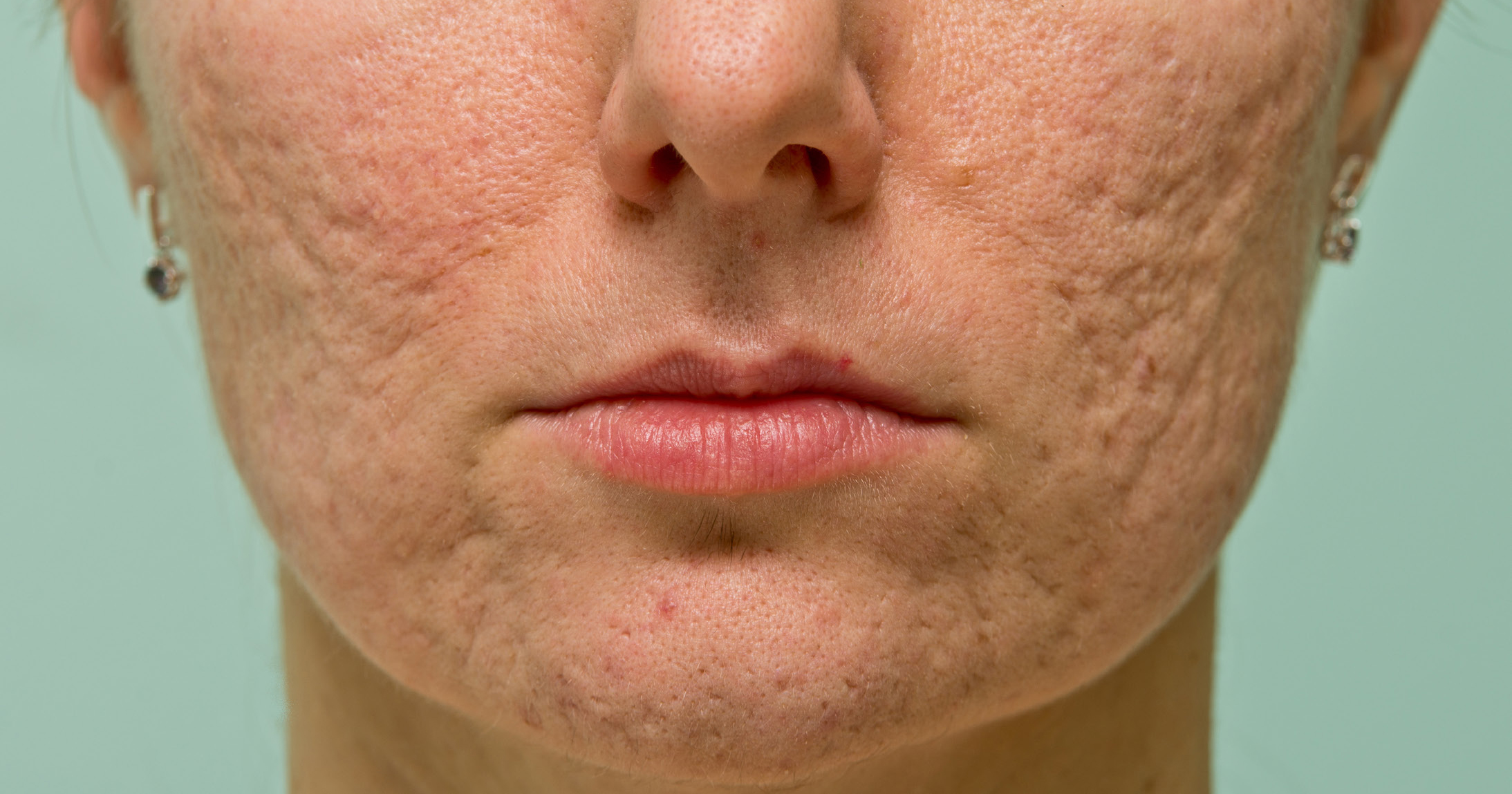

Acne is a disease of the hair follicle and its associated sebaceous gland, collectively known as the pilosebaceous unit. Abnormal keratinisation, excess sebum production and overgrowth of the anaerobic bacteria Cutibacterium Acnes leads to rupture of the hair follicle and tissue injury. This cascade of events stimulates wound healing, a process that can ultimately lead to scar formation.
The initial steps of wound healing involve migration of inflammatory cells to the site of tissue injury, production of type I and type III collagen by fibroblasts and remodelling of the extracellular matrix. Fibroblasts and keratinocytes produce matrix metalloproteinases (MMPs) and tissue inhibitors of MMPs. The former are lytic enzymes that break down the extracellular matrix. An imbalance between the two groups of enzymes can lead to excess collagen production and hypertrophic (elevated) scars or excess degradation of extracellular matrix and atrophic (depressed) scars. There are three types of atrophic scars: ice pick, boxcar and rolling.
Preventing acne scarring
Acne scarring can be prevented by switching off the inflammation with appropriate medical treatments. Patients with nodulocystic acne and skin of colour are at increased risk of scarring and should be treated more aggressively, with a low threshold for escalating to oral retinoids (i.e. isotretinoin (Roaccutane)).
Does picking increase acne scarring?
Picking causes traumatic injury to acne lesions, which stimulates the wound healing cascade and the potential for scarring. It can also introduce secondary bacterial infection.
Treating acne scarring
As previously mentioned, atrophic scars include ice pick scars, rolling scars and boxcar scars. They can be treated with the following modalities:
Chemical peels
Peeling involves using chemicals to destroy damaged layers of the skin and stimulate the repair process. Peeling works best for flat scars, but it can also help to improve the appearance of hyperpigmentation. However, ice pick and boxcar scars will not disappear with peeling; their appearance will improve with sequential treatments. The trichloroacetic acid (TCA) cross technique involves local application of high concentrations of TCA and has been shown to be effective in treating ice pick scars.
Subcision
Subcision is a minor surgical procedure in which a cannula or a needle is used to break down fibrous bands that cause tethering of the scar. This treatment is helpful for rolling scars.
Microneedling
Microneedling uses fine needles in a pen or roller that penetrate the dermis and induce micro-bruising, leading to cytokine release and collagen production. The procedure stimulates collagen production within the skin layers and helps to improve the texture of the skin.
Punch excision
Punch excision is a minor surgical procedure in which a punch biopsy is used to excise an atrophic scar. The defect is subsequently closed with sutures. This can be a helpful technique for boxcar and icepick scars, and it will improve skin texture.
Laser treatment
Different types of lasers can be used to treat acne scarring. Ablative lasers vaporise scar tissue and can be used to resurface the skin and improve the texture. Erbium YAG and C02 are the most common ablative lasers that are used to treat acne scars. Non-ablative lasers stimulate new collagen formation, leading to skin tightening. They have a shorter recovery period post treatment. Non-ablative lasers include the Nd:YAG and diode lasers.
Treating hypertrophic scars
Hypertrophic scars are elevated scars due to excess collagen production. They can be treated using the following treatment modalities:
Silicone-based products
Silicone-based products have been shown to promote the flattening of hypertrophic scars over time.
Intralesional corticosteroid injections
Intralesional corticosteroid injections are the most commonly used treatment for hypertrophic scars. They can reduce scar volume and improve texture, in addition to reducing itching. There is not a complete understanding of how they work, but vasoconstriction and a reduction in mitotic activity are thought to play a role. They can be used in combination with other treatments. Patients should be warned of the risk of lipoatrophy and scar indentation.
Pulsed dye laser
Pulsed dye laser has been shown to be effective in the treatment of hypertrophic and keloid scars. It is thought to decrease the deposition of type III collagen and increase the activity of collagenases, promoting scar degradation.
Skin surgery
Skin surgery can be used to remove or disrupt scars. Care must be taken in patient selection, as it can potentially make scarring worse.
The first step in treating acne scarring
The first step should be to ensure the acne has been ‘switched off’. If the patient has active acne, they are at risk of developing further scarring. Once the acne has been adequately treated, the type of scarring should be identified, so that an appropriate treatment strategy can be created.
Case study
A male patient aged 25 years with type V skin was referred to the author's clinic for treatment of his acne, atrophic scars and hyperpigmentation. He had papulopustular acne affecting the face, with post-inflammatory hyperpigmentation and ice pick scars on the cheeks. The first stage of treatment involved switching off the inflammatory process. He completed a 3-month course of doxycycline 100 mg daily, and Epiduo (adapalene/benzoyl peroxide) 0.3%/2.5% gel three times weekly. This led to clearance of the acne. The hyperpigmentation was addressed with 15% azelaic acid and Heliocare 360 sunscreen. Microneedling was used to improve the skin texture.



